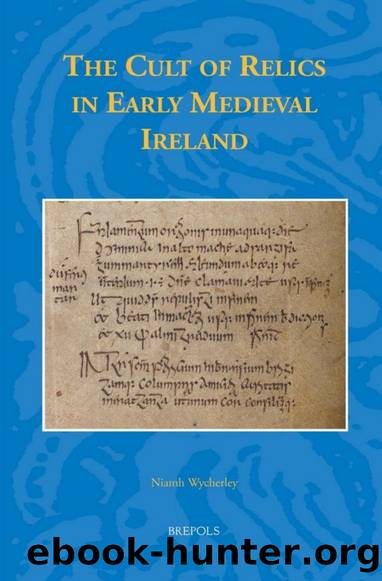The Cult of Relics in Early Medieval Ireland by Niamh Wycherley

Author:Niamh Wycherley [Wycherley, Niamh]
Language: eng
Format: epub
ISBN: 9782503551845
Google: c9yNrgEACAAJ
Amazon: 250355184X
Barnesnoble: 250355184X
Goodreads: 28206096
Published: 0101-01-01T00:00:00+00:00
Chapter 5
it still merits discussion here in order to place it within the wider context of the cult of relics as a whole in early Irish history.
Relics and Oath Taking
The end of the seventh century and the beginning of the eighth appear to have been a particularly difficult period in Irish society, characterized by famine, disease, and political upheaval.2 Against this backdrop, the Church may have promoted the cult of saints partly to provide comfort and hope during tumultuous times. As Doherty has pointed out, both the cult of relics and the production of hagiography were well underway by the end of the seventh century, reflecting the development of an organized cult of saints at this time.3 Saints acted on their communityâs behalf. This is evident in a seventh-century Old Irish hymn attributed to Colmán of the moccu Chluasaig, in response to the Yellow Plague.4 The poem beseeches the saints of the Bible for protection against plague and famine:
Itge Abéil maicc Adaim, Hele, Enoc, diar cobuir: ronsoerat ar diangalar sechip leth fon mbith foguir. Noe ocus Abraham, Isac in macc adamrae immuntÃsat ar thedmaim náchantairle adamnae [â¦] Iohain Baptaist adsluinnem rop ditiu dún rop snadud! Ãsu cona apstalaib rop diar cobuir fri gábud!
May the prayer of Abel son of Adam, Enoch, Elias help us; may they save us from swift disease (?) on whatever side, throughout the noisy world! Noah and Abraham, Isaac the wonderful son, may they surround us against pestilence, that famine may not come to us! [â¦] John the Baptist we invoke, may he be a safeguard to us, a protection! may Jesus with His apostles be for our help against danger!5
Scholars have explored how the generation of hagiography (and the associated cult of relics) was key to facilitating the creation and promotion of saintsâ
cults.6 Very often vested interests fuelled the effective growth and advertise-2 à Corráin, âIreland c. 800â, pp. 580â84; Doherty, âExchange and Tradeâ, p. 71.
3 Doherty, âUse of Relicsâ, p. 94.
4 Thes. Pal., ii, 298â306; MacNeill, âA Pioneer of Nationsâ, p. 438, seems to accept Colmánâs authorship although the last part of the hymn is attributed to Diarmait úa Tigernáin, coarb of Armagh in the mid-ninth century. Kenney, Sources, pp. 726â27, dates the language to the first half of the ninth century.
5 Thes. Pal., ii, 300â01.
6 For a useful overview of the scholarly developments in this area, see Howard-Johnston and Hayward, The Cult of Saints.
The Formal Use of Relics in Early Ireland
131
ment of these cults, and it is in this enterprise that we can gain an interesting insight into the interactions between ecclesiastical and secular authorities in medieval Europe. For example, social anthropologist Mary Douglas elucidates the ways in which hierarchical societies use times of difficulty and suffering to uphold the moral law and reinforce social discipline.7 In the Irish context, the eighth-century sabbatarian ordinance Cáin Domnaig implies that maintenance of the law of the Sabbath would prevent the wrath of God and pestilence on the fields: âAr is ar tairmthecht Domnuig do-beir DÃa
Download
This site does not store any files on its server. We only index and link to content provided by other sites. Please contact the content providers to delete copyright contents if any and email us, we'll remove relevant links or contents immediately.
| Belgium | France |
| Germany | Great Britain |
| Greenland | Italy |
| Netherlands | Romania |
| Scandinavia |
Room 212 by Kate Stewart(4108)
The Crown by Robert Lacey(4108)
Endurance: Shackleton's Incredible Voyage by Alfred Lansing(3845)
The Iron Duke by The Iron Duke(3641)
The Rape of Nanking by Iris Chang(3518)
Killing England by Bill O'Reilly(3457)
Joan of Arc by Mary Gordon(3260)
Say Nothing by Patrick Radden Keefe(3062)
I'll Give You the Sun by Jandy Nelson(2842)
Hitler's Monsters by Eric Kurlander(2734)
Shadow of Night by Deborah Harkness(2720)
Margaret Thatcher: The Autobiography by Thatcher Margaret(2687)
Mary, Queen of Scots, and the Murder of Lord Darnley by Alison Weir(2678)
Darkest Hour by Anthony McCarten(2648)
Blood and Sand by Alex Von Tunzelmann(2610)
Red Famine: Stalin's War on Ukraine by Anne Applebaum(2466)
Eleanor & Park by Rainbow Rowell(2394)
The One Memory of Flora Banks by Emily Barr(2349)
Book of Life by Deborah Harkness(2265)
